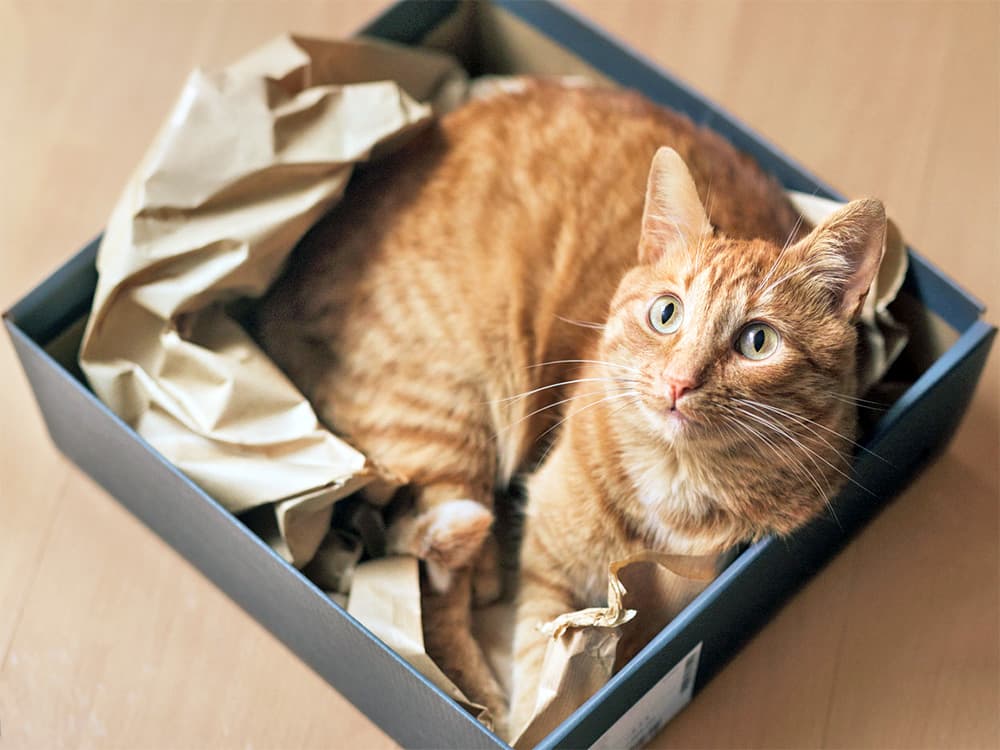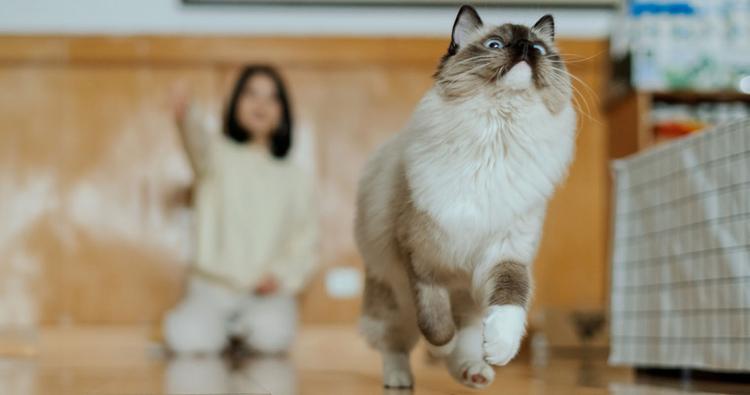12 Orange Cat Breeds Who’ll Add Love (and Chaos) to Your Home
These energetic cats can make for entertaining pets. Here’s your guide to some of the most popular orange cats.
These energetic cats can make for entertaining pets. Here’s your guide to some of the most popular orange cats.
by Alicia Kort, | November 20, 2024

AllNikArt / Adobe Stock
So you’ve probably heard about how orange cats are just built differently than felines of other colors. Orange cats are known for being high-energy, agents of chaos, fun, friendly, and sometimes, not the brightest bulb in the box. Of course, these are all stereotypes and jokes people make on the Internet. Each cat is an individual and comes with a unique personality. You might end up with the calmest, sweetest, and smartest ginger out there, or you might spend the rest of your days cooing to your cat about how they seem to share a single brain cell with the other orange cats out there. We make no promises.
But now that you’ve heard about “orange cat behavior,” and if you are 100 percent on board with it, read on to learn more about ginger cats, why their coloring is unique, and their various breeds. We’ll also debunk some stereotypes along the way.

Ibex.media / Stocksy
The Domestic Shorthair is basically the mutt of cats and the most popular house cat on the planet. They can be a variety of colors (including orange, obviously), sizes, and temperaments. This mix is known for being playful and having a lot of stamina, which is why they used to serve as mousers. They are social creatures and tend not to be too territorial, making them perfect pets for seniors or families with children.
Weight: 6 to 16 pounds
Best Trait: Family-friendly

Irina Gutyryak / Shutterstock
In contrast with the Domestic Shorthair, the American Shorthair is usually more selectively bred. One of the main differences between the two breeds is that American Shorthairs have round faces, which give off the appearance of being cute and affectionate (even when they’re misbehaving) and muscular bodies. They’re intelligent, family-friendly, and need some play time to remain happy. If you’re on the hunt for an orange American Shorthair cat, the cat will likely have a tabby pattern in their fur, rather than being solidly orange.
Weight: 6 to 15 pounds
Best Trait: Sweet personality

Jilin Su / Shutterstock
Yes, we’ve got one more shorthair cat on this list. The way the British Shorthair differs from the other two breeds is they originated in Great Britain (likely as street cats), and are famous for their round, pouty cheeks that cause them to resemble a stuffed teddy bear. When they’re orange, they usually have yellow-gold eyes that match their fur, causing them to look like little lions (they’re just missing the halo of mane!). Shorthairs are quiet but playful cats who tend to get along with families and other household pets.
Weight: 6 to 15 pounds
Best Trait: Big teddy bear

Casey Elise Christopher / Shutterstock
You have no doubt seen pictures of Maine Coon pet parents proudly showing off how big their cat is. If you decide on a long-haired Maine Coon, this fluffy beast will resemble an orange lynx in your home. This large cat breed has a heavy coat that requires plenty of maintenance, which potential pet parents should keep in mind. Despite their intimidating size, Maine Coons are known for being gentle, curious, and pretty big talkers, which makes them good pets for families. Expect them to have opinions if you serve them dinner late.
Weight: 9 to 20 pounds
Best Trait: Fluffy giants

totojang1977 / Shutterstock
Lovingly referred to as furry furniture, the Persian breed, which can have gorgeous copper fur, likes to get their beauty sleep. This cat has a perpetually grumpy face — even after sleeping for nearly 10 hours straight — but they’re delicate, affectionate sweeties underneath all of that fur. They’d thrive in a quiet home and would also make perfect pets for seniors. As mentioned earlier, they are small, so they might be stressed out by an environment with children and can’t tolerate roughhousing. Their fluffy coats do require some maintenance, though they only shed a moderate amount.
Weight: 7 to 12 pounds
Best Trait: Sleepy sweetheart

Chamomile_Olya / Shutterstock
The Cornish Rex is certainly a unique-looking cat, which is the highest of compliments obviously. Boasting curly fur, big bat-like ears, and extra-long limbs, the Cornish Rex can sometimes have red hair. They always look a little bit like they’ve been roused from a particularly deep sleep and are high-energy cats, so expect a red Cornish Rex to have Big Orange Cat energy. These affectionate and friendly cats are great with older kids and other pets. One important thing to note is that because their fur is special, they are more sensitive to temperatures, so their homes should be adequately heated or cooled.
Weight: 8 to 10 pounds
Best Trait: Curly fur

Евгений Вершинин / Alamy Stock Photo
The American Bobtail might look like they escaped from a forest, but this cute kitty is anything but aloof. They are known for being sweet, affectionate, and playful. This breed loves to be around their families and can even be dog-like — some Bobtails like to play fetch. Although the American Bobtail cat can be orange, they tend to favor fur colors that are found in the wild, to blend in with their natural habitats. Bobtails will need to be brushed weekly and have a big shed twice a year.
Weight: 8 to 16 pounds
Best Trait: Little tails

Marie Charouzova / Shutterstock
Hailing from the forests of Russia, this regal cat is highly intelligent and a great family pet. The Siberian can have orange or red fur, which means they usually have a magnificent ruff of fur around their necks (along with a thick coat everywhere else). This beautiful fur does come with a price: constant shedding and brushing that potential pet parents should be prepared for. It’s also recommended that pet parents get their Siberian some cat trees and provide high perches, because they love to show off how high they can jump with their powerful back legs.
Weight: 15 to 20 pounds
Best Trait: Luxurious fur

VH-studio / Shutterstock
When you see a Devon Rex with an orange or red coat, it’ll usually have a pattern, rather than being solid, or be mixed with white. This kitty is high-energy and highly intelligent, so expect many orange cat antics if you don’t keep them stimulated. They can be trained to do tricks, which is one way to bond with your cat. While no cat is technically hypoallergenic, the Devon Rex is a low-shed feline with a short coat of fur, making them a better choice if one of their pet parents suffers from a mild to moderate cat allergy.
Weight: 6 to 9 pounds
Best Trait: Low-shedding

Justin Lim / Stocksy
The Exotic Shorthair is a mix of a Persian with an American Shorthair. When they do have an orange coat, it’s a solid golden-orange one that comes with striking gold, blue, or green eyes. This mix is considered pretty mellow (for a cat, mind you, so they’ll always have the occasional zoomies or moments of chaos), because they have lower exercise needs. This is not to say that they don’t like to play, but they don’t need as much playtime as other cats on this list. The Exotic Shorthair also has a more manageable coat than the Persian and only requires brushing one to two times per week.
Weight: 9 to 15 pounds
Best Trait: Mellow

elesi / Shutterstock
Unofficially dubbed the “Dobby” cat, due to this breed’s resemblance to the House Elf character in the Harry Potter franchise, the Oriental Shorthair is certainly a unique-looking cat with a big personality to match. When the Oriental Shorthair is orange (often with stripes), they resemble Tigger from Winnie the Pooh. This cat loves to be around people and other pets, which goes against the feline stereotype. They can even act out if they are left alone for too long. The Oriental Shorthair would spend all day playing if they could. They enjoy mentally stimulating games, learning tricks, and climbing (be sure to invest in high perches).
Weight: 8 to 12 pounds
Best Trait: Big ears

Heidi Bollich / Shutterstock
The Selkirk Rex looks like they got up on the wrong side of the bed — in the cutest possible way. This breed is native to the United States and their temperament typically does match their coats, making them great pets for families and seniors. They don’t really care that they just rolled out of bed and honestly, would still prefer to be napping — or at the very least, lounging in the sun. The Selkirk Rex’s coat needs to be brushed with a wide-toothed comb, and this cat does need to be bathed. (Unlike other cat fur, this breed’s loose fur doesn’t end up all over your clothes and furniture, it stays on the cat.) This can cause mats if they’re not properly cared for.
Weight: 8 to 12 pounds
Best Trait: Ruffled coat
If you’re ready to add orange-cat energy to your home, check out Adopt a Pet to search in your area for ginger cats — you can also search by breed — who need adoption. You can also visit your local shelters or rescues.
Orange cats have a reputation for being affectionate, friendly, chaotic, and also a little silly. (Just look at Garfield.) Orange cats also tend to be male, which is unique in the cat world.
Orange cat fur occurs due to a dominant gene, as does black fur.
Orange cats are so unique because the orange fur color is linked to the X chromosome. Male cats have one X chromosome, so they’re much more likely to be orange than female cats. Female cats have two X chromosomes, so both of their parents need to be orange to appear orange. According to The Daily Wag, eight of 10 orange cats are male.
Although male orange tabby cats aren’t rare, female orange tabby cats are considered rare.
The health issues orange cats, especially the males, are prone to include obesity, urinary tract infections, and the blood-clotting disorder Hemophilia B.
Whether or not an orange cat is high maintenance depends on the cat themself. Each cat is an individual and can buck breed standards, so you never know if your cat is going to be low- or high-maintenance. If you are worried about having a high-maintenance cat, we recommend looking at some of the cat breeds, above, with shorter, low-shedding coats. That being said, if you have a pet, you should be prepared to devote whatever time, energy, and money they require. They are a life-long commitment.

Alicia Kort is a writer and editor living in Brooklyn. She’s currently the senior commerce editor at Apartment Therapy. She’s been published in StyleCaster, Electric Literature, Newsweek, Interview, Brooklyn magazine and more. In her free time, she runs, reads, and spends time with her dog-nieces, Maya and Lady, and her cat-niece, Pepper.

Breed Info

Breed Info

Breed Info

Breed Info
Here’s a quick guide to finding the right gray or silver cat for you.

Breed Info
Thinking of adopting a cat but wondering if they’ll get along with your pup? Find out which cat breeds are more dog-friendly — and dog-like.

Breed Info

Breed Info
The science behind these chocolate-colored felines.

Breed Info
These affectionate cats are basically love wrapped in fur.

Adoption Advice
You’re ready to adopt a feline, but is a short- or long-hair the way to go? We weigh the pros and cons.